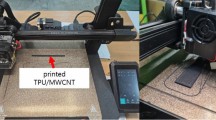Abstract
The use of direct-write (DW) in the fabrication of conductive structures offers dramatic benefits over traditional technologies in terms of low-cost, print-on-demand conformal manufacturing. This DW process can be combined with direct-cure (DC) process as one-step manufacturing of conducting elements, whereas conventional methods need a manufacturing process of conducting elements followed by a relatively long time post-curing/baking process. A hybrid technology combined with direct-write/cure (DWC) and projection microstereolithography (PμSL) is presented in this work. Carbon nanotubes (CNTs) were dispersed in a photopolymer solution to introduce conductivity. The developed PμSL was used to create 3D structures, and DWC of conductive photopolymers with CNTs was utilized to produce conductive paths. To show the capabilities of the developed system and materials, a 3D structure with embedded conductive paths was designed and fabricated. Based on the experiments, it is thought that the suggested manufacturing process and materials are promising to produce 3D structural electronics.
Similar content being viewed by others
References
J. A. Palmer, J. L. Summers, D. W. Davis, P. L. Gallegos, B. D. Chavez, P. Yang, F. Medina and R. B. Wicker, Realizing 3-D interconnected direct write electronics within smart stereolithography structures, Proc. of International Mechanical Engineering Congress and Exposition, Orlando, Florida, USA (2005).
M. Navarrete, A. Lopes, J. Acuna, R. Estrada, E. Mac- Donald, J. Palmer and R. Wicker, Integrated layered manufacturing of a novel wireless motion sensor system with GPS, Proc. of the 18th Annual Solid Freeform Fabrication Symposium, Austin, Texas, USA (2007) 575–85.
A. J. Lopes, E. MacDonald and R. B. Wicker, Integrating stereolithography and direct print technologies for 3D structural electronics fabrication, Rapid Prototyping J., 18(2) (2012) 129–143.
M. Vatani, Y. Lu, K. S. Lee, H.C. Kim and J. W. Choi, Direct-Write stretchable sensors using single-walled carbon nanotubes/polymer matrix, J. of Electronic Packaging, 13 (2013) 1–5.
L. L. Lebel, B. Aissa, M. A. E. Khakani and D. Therriault, Ultraviolet-assisted direct-write fabrication of carbon nanotube/polymer nanocomposite microcoils, Advanced Materials, 22 (2010) 592–596.
R. A. Barry III, R. F. Shepherd, J. N. Hanson, R. G. Nuzzo, P. Wiltzius and J. A. Lewis, Direct-write assembly of 3D hydrogel scaffolds for guided cell growth, Advanced Materials, 21 (2009) 2407–2410.
J. H. Sandoval, K. F. Soto, L. E. Murr and R. B. Wicker, Nanotailoring photocrosslinkable epoxy resins with multiwalled carbon nanotubes for stereolithography layered manufacturing, J. of Material Sci., 42 (2007) 156–165.
Spectra group limited, Inc., Enabling technology in photochemistry photochemical products and services contract research and development (2011).
J. W. Choi, R. B. Wicker, S. H. Cho, C. S. Ha and S. H. Lee, Cure depth control for complex 3D microstructure fabrication in dynamic mask projection microstereolithography, Rapid Prototyping J., 15(1) (2009) 59–70.
Y. L. Cheng, M. L. Li, J. H. Lin, J. H. Lai, C. T. Ke and Y. C. Huang, Development of dynamic mask photolithography system, Proc. of 2005 IEEE International Conference on Mechatronics, Taipei, Taiwan, China (2005).
TEXAS INSTRUMENTS, Single-panel DLPTM projection system optics, Application Report (2005).
TEXAS INSTRUMENTS, Single-panel DLPTM projection system optics, Application Report (2005).
J. W. Choi, E. MacDonald and R. Wicker, Multi-material microstereolithography, International J. of Advanced Manufacturing Technology, 49 (2010) 543–551.
Y. M. Ha, J. W. Choi and S. H. Lee, Mass production of 3-D microstructures using projection microstereolithography, J. of Mechanical Sci. and Technology, 22 (2008) 514–521.
P. F. Jacobs, Rapid prototyping and manufacturing: fundamentals of stereolithography, Society of Manufacturing Engineers, (1992) 81–92.
Author information
Authors and Affiliations
Corresponding author
Additional information
Recommended by Guest Editor Haedo Jeong
Yanfeng Lu obtained his M.S. and B.S. degrees in the School of Mechanical Engineering and School of Chemical Engineering from Dalian University of Technology (DUT), China in 2011 and 2007, respectively. He currently works as a Ph.D. candidate in the Department of Mechanical Engineering at The University of Akron with Dr. Jae-Won Choi. His main research interests include the direct-print/cure system, 3D structural electronics, and micron additive manufacturing.
Morteza Vatani is currently a Ph.D. candidate in Mechanical Engineering at the University of Akron under direction of Dr. Jae-Won Choi. He received his M.S. degree in Mechanical Engineering/Manufacturing from Amirkabir University of Technology in Iran in 2009. His Thesis work was mainly focused on prediction of curl distortion in SL parts. He has also experience in developing slicing algorithm in stereolithography and developing micro stereolithography machine. His current research focuses on developing stretchable piezoresistive sensing material and developing a hybrid direct write-additive manufacturing system.
Jae-Won Choi is an Assistant Professor in the Department of Mechanical Engineering at the University of Akron (UA). Prior to joining the UA, he spent three years for Micro/Macro Additive Manufacturing in the W.M. Keck Center for 3D Innovation at the University of Texas at El Paso (UTEP). His B.S., M.S., and Ph.D. degrees were obtained from Pusan National University (PNU) in South Korea in 1999, 2001, and 2007, respectively, with a strong background of advanced manufacturing technologies. His research interests include Advanced Multi-Scale, Multi-Material Additive Manufacturing, Stretchable Sensors, Tissue Engineering, Biomedical Devices, Transdermal Drug Delivery, 3D Electronics, and Direct Writing.
Rights and permissions
About this article
Cite this article
Lu, Y., Vatani, M. & Choi, JW. Direct-write/cure conductive polymer nanocomposites for 3D structural electronics. J Mech Sci Technol 27, 2929–2934 (2013). https://doi.org/10.1007/s12206-013-0805-4
Received:
Revised:
Accepted:
Published:
Issue Date:
DOI: https://doi.org/10.1007/s12206-013-0805-4




